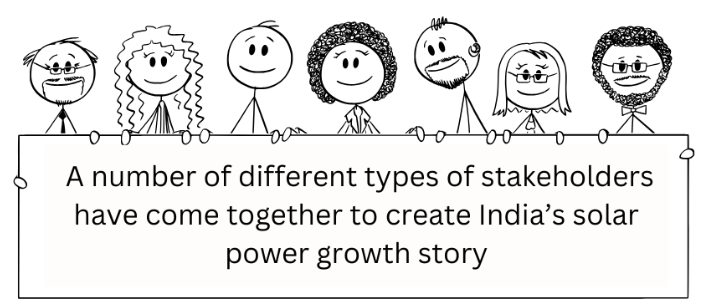Themes in this post: Government | Power companies | Corporates | Small businesses | Manufacturers | Installers | Startups | Investors
It was sometime in 2010 and in a spacious auditorium in Delhi. This was the first ever large meeting I was attending for solar power in India, convened by the MNRE to make announcements of their latest policies for India’s solar power sector. It indeed was quite an impressive one. In front of me, on the stage was Deepak Gupta, the then MNRE secretary handling questions and answers from the audience in a confident, impressive and at times somewhat imperious, manner. What impressed me even more than the speeches and presentations was the wide range of stakeholders that was present under one roof.
To most from outside the industry, it appears as if the solar panel makers and the installers are the key to the growth of this sector. Definitely, these two stakeholder segments, the most visible, play important roles. But you might be surprised to know that they are only part of a much larger group of stakeholders, that comprises:
- Government
- Power companies
- Manufacturers of solar cells, panels and balance of systems
- Solar power plant installation & maintenance providers
- Consumers
- Startups
- Investors & financiers
Let’s look briefly at what each of these stakeholders do in this section – I devote a chapter each to each of these stakeholder categories, the links for which are given right under the corresponding section.
Government
The government part of the solar power ecosystem comprises both central and state government ministries and organizations governed by them.
At the central government level, key decisions are made by the Ministry of New & Renewable Energy, MNRE (a trivia: India was the first country in the world to have a #Hdedicated ministry for renewable energy!#H).
The MNRE in turn has a number of organizations under it, performing various functions and coordinating the actions. These include government-owned organizations such as SECI (solar energy corporation of India) and also state renewable energy nodal agencies.
At the state level, renewable energy and solar power are handled usually by the Energy or Power Ministry. States again could have different organizations working under them, in addition to state- owned power utilities. Read more about the role of government in solar power.
Power companies
Power companies comprise those that generate and distribute power to end users. In addition to the government-owned power companies, private utility firms such as Tata Power, Adani Power, Reliance Power, Torrent Power etc., also play a significant role as well by generating and distributing solar power in addition to conventional power. Read more about the role of power companies in the solar power sector.
Manufacturers
These are the companies that make solar cells, panels, inverters, mounting structures, electricals, junction boxes, battery systems and more.
Most of the Indian solar manufacturing today happens in the midstream and downstream portions of the value chain. In future, there will also be companies in the upstream portion of solar manufacturing – companies that make polysilicon, ingots and the silicon wafers. Read more about the solar power sector manufacturers.
Developers & installers
In addition to conventional power companies generating solar power, there are power generation companies that only generate renewable power, mainly solar and/or wind power (with a sprinkling of hydro in some cases). Examples of these include ReNew Power, Azure Power, Greenko, Avaada etc. So, these are the developers of solar power plants.
#HInstallers (also called EPCs – standing for Engineering, Procurement and Construction – companies)#H are the businesses that actually install the solar power plants. While the developers own the solar power plants, the installers get it started. An analogy is a new house you build – you are the owner (developer) of the house, while the company that does the construction is the EPC.
In many cases, the solar power developers also double up as installers/EPCs.
Read more about the role of developers and installers in the solar power ecosystem.
Consumers
This stakeholder group is about the “you and me”, and companies factories and commercial establishments. This group represents the solar power consumer segment, and is broadly classified into industrial (factories and such), commercial (hotels, colleges, offices etc.), public (government owned establishments such as government offices, public buildings, railway stations etc.), agricultural (farmers) and residential (the “you and me”).
Read more about the end use sectors of solar power in India.
Pioneers & startups
The Indian solar power sector is currently witnessing significant participation from startups and innovators. Interestingly, some of these innovators and innovations are focussing not on manufacturing any of the core components (panels, inverters, etc.), but in accelerating distributed solar power plant deployment, and on developing a range of support solutions – all the way from providing design support to making robots and drones for solar power plant monitoring & maintenance.
Read more about the Indian solar power sector’s startups and pioneers.
Investors & financiers
While the costs of solar power plants have come down, putting up large solar power plants still needs significant capital. This is being provided by a range of finance sector stakeholders that comprise the traditional banking and financial institutions, to venture capital firms investing in startups, and other financial institutions & programs such as mutual funds, development finance institutions & CSR funds.
Read more about the financial investment segment’s role in India’s solar power sector.
 Skip to content
Skip to content



